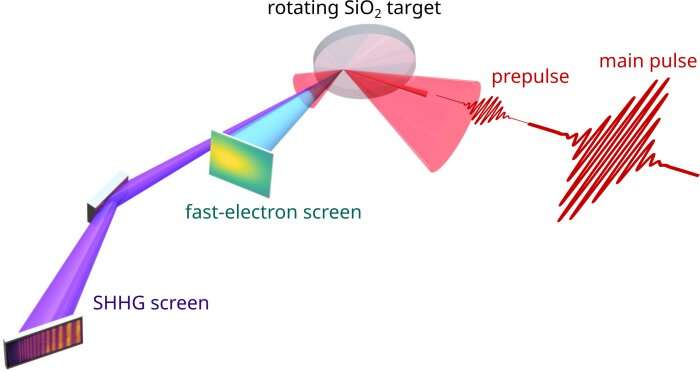Schematics of the experimental setup for SHHG and electron acceleration on a kHz plasma mirror. Credit: Ultrafast Science (2022). DOI: 10.34133/2022/9893418
Scientists at the LOA (Laboratoire d'Optique Appliquée) in France succeeded for the first time to drive at a thousand shots per second a so-called plasma mirror in the relativistic regime (i.e., with a laser-field so strong that it hurls the plasma-electrons back and forth at nearly the speed of light.
When an intense laser pulse ionizes the surface of a solid target, it creates plasma so dense that it is impenetrable to the laser, even if the target was initially transparent. The laser now gets reflected off this "plasma mirror". In the relativistic regime, the mirror surface no longer just sits stills but is driven to oscillate so fast that, through a process called relativistic surface high-harmonic generation (SHHG), it temporally compresses the laser's electro-magnetic field cycles.
This concentrates the laser energy further in time and makes plasma-mirrors a promising path for the generation of ever more intense and shorter laser pulses.
Their use and fine control does however place extremely high demands on the driving laser such as pristine spatiotemporal pulse quality and temporal contrast, as well as a huge peak power of terawatts. This had only been achieved in single-shot experiments made with much bigger lasers that operate at ≤ 10 Hz repetition rate.
The team around Stefan Haessler and Rodrigo Lopez-Martens now report evidence for relativistic SHHG driven at kilohertz repetition rate. Simultaneously with the SHHG emission, a correlated beam of relativistic electrons is observed. This is a major step from hitherto few-shot exploratory experiments towards a usable secondary radiation and particle source for applications.
A key element for this progress is the in-house developed kilohertz repetition rate terawatt laser, providing pulse durations down to <4 femtoseconds and a temporal contrast ratio (between the pulse intensity at its peak and 10 picoseconds before) of 1010. The other is the laser-plasma interaction platform that is adapted to the high repetition rate and enables fine control of the interaction conditions.
This is achieved notably through a preceding laser pulse which initiates the plasma creation and expansion. Varying the time delay after which the subsequent main driving pulse is fired lets the researchers control the nanometer-range density gradient on the plasma mirror surface. For the first time, the effect of this gradient has been studied in detail for three increasingly short and intense driving pulses.
In a next step, the scientists plan to work on refocusing the radiation reflected off the plasma mirror and target reaching record-high light intensities for light pulses shorter than a femtosecond.
The findings are published in the journal Ultrafast Science.
More information: Stefan Haessler et al, High-Harmonic Generation and Correlated Electron Emission from Relativistic Plasma Mirrors at 1 kHz Repetition Rate, Ultrafast Science (2022). DOI: 10.34133/2022/9893418
Provided by Ultrafast Science






















